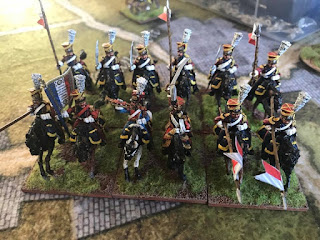Like most wargamers interested in the Napoleonic era I eventually found myself drawn to attempting to recreate at least some part of Napoleon's 'Guard Imperial'.
The main motivation for doing so was my avid interest in The 100 Days (Waterloo) Campaign of 1815.
Many gamers of the period shun this campaign due to the fact it's a rather small campaign in comparison to the campaigns or 1805-06, 1809 or 1812-14.
Also, the British and her allies (or The Allies and the British) are not the traditional 'Stovepipe Shako wearing' icons we associate with The Duke of Wellington but a rather 'ignominious army'.
But for me I find it a fascinating campaign full of 'What Ifs'. Napoleon concieved a brilliant strategy but his execution was abysmal.
Anyway, it's also a campaign where we see his Guard pitching in unlike most campaigns where its held in reserve. The exception being the 1814 Campaign for France where The Guard was heavily involved,...
My French Imperial Guard not surprisingly is based on that Guard that was involved in the Waterloo Campaign.
I've gone with using exclusively the magnificent PERRY MINIATURES range in 28mm throughout.
So here they are so far,... (I've still to add the Polish Lancers).
FLAGS from GMB.
I've included a little blurb on each regiment obtained from Wikipedia (if you can believe that)!
The Chasseurs à Cheval de la Garde Impériale (in English: Horse Chasseurs of the Imperial Guard) constituted a light cavalry regiment in the Consular, then Imperial Guard during the French Consulate and First French Empire respectively. They were the second senior "Old Guard" cavalry regiment of the Imperial Guard, after the Grenadiers à Cheval. The regiment had its origins in the Guides raised by General Bonaparte during his Italian Campaign of 1796. It was the Chasseurs that usually provided personal escort to Napoleon, and he often wore the uniform of the regiment in recognition of this service. The regiment was not only known for its lavish uniform, but its combat history as well.
Chasseurs à cheval (on the left) protecting the Emperor at the Battle of Friedland, while cuirassiers salute him before their charge.The Emperor is again in his green colonel uniform of the Chasseurs à Cheval.
The Dragons de la Garde impériale (Dragoons of the Imperial Guard) was a heavy cavalry unit formed by Napoleon I through the decree of April 15, 1806. The "dragoon" regiments of the line had distinguished themselves in the German Campaign of 1805, and therefore Napoleon decided to reorganize the cavalry of the Guard and create within it a regiment of dragoon guards. This regiment was colloquially known as the Dragons de l'Impératrice (Empress' Dragoons), in honor of Empress Joséphine. Following the Bourbon Restoration, they were renamed Corps royal des Dragons de France (Dragoons of France Royal Corps) but were disbanded shortly afterwards.
The Empress Dragoons at the battle of Hanau
The Gendarmes d'élite de la Garde impériale (English: "élite gendarmes of the Imperial Guard") was a gendarmerie unit formed in 1801 by Napoleon as part of the Consular Guard which became the Imperial Guard in 1804. In time of peace, their role was to protect official residences and palaces and to provide security to important political figures. In time of war, their role was to protect the Imperial headquarters, to escort prisoners and occasionally to enforce the law and limit civil disorder in conquered cities. The unit was renamed Gendarmes des chasses du roi during the First Bourbon Restoration but was disbanded in 1815 during the Second Restoration.
The Grenadiers à Cheval de la Garde Impériale (in English: Horse Grenadiers of the Imperial Guard) constituted a heavy cavalry regiment in the Consular, then Imperial Guard during the French Consulate and First French Empire respectively. They were the senior "Old Guard" cavalry regiment of the Imperial Guard and from 1806 were brigaded together with the Dragons de la Garde Impériale.[1]
A part of the Republican Consular Guard, the Grenadiers became the senior "Old Guard" heavy cavalry regiment when the Imperial Guard was founded, in 1804. Their maximum official complement was just over 1100 officers and troopers, commanded by a general of division or a seasoned general of brigade, with some of the most famous cavalrymen of the time as commander.
Rarely committed to battle during the Napoleonic Wars, they were usually kept in reserve, alongside the Emperor, during the most significant battles of 1804-1815. When sent into action, such as during the battles of Marengo, Austerlitz, Eylau, Hanau or Waterloo, as well as during a number of actions of 1814, results were usually impressive. The regiment was disbanded in 1815, after Napoleon's downfall and the second restoration of the Bourbons.
"Heads up, gentlemen, these are bullets, not turds". Colonel Louis Lepic harangues the Grenadiers à Cheval as they are forming for a charge under intense fire at the Battle of Eylau in 1807. Painting by Édouard Detaille at the Chantilly Museum.
The 2e régiment de chevau-légers lanciers de la Garde Impériale (English: 2nd regiment of light cavalry lancers of the Imperial Guard) was a light cavalry regiment in Napoleon I's Imperial Guard.[1][2] They were formed in 1810, after the Kingdom of Holland was annexed by France, but their original purpose was to serve as hussars of the Dutch Royal Guard.[1][2] The units, who were of an elite order, were known for their loyalty and military might, as well as their professionalism in and out of battle
































